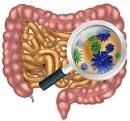|
Gut Instincts – Microbial Biodiversity
Did you know that your gut bacteria says a lot about what you eat? and it may also predict your tendency to chronic disease and obesity.Your gut harbor’s a staggering 100 trillion bacteria which include around 4,000 different species, all carving out their niches within the folds of your unique gut environment – known as your microbiome. Maintaining diversity and balance in your microbiome may be the key to overall good health. We have all experienced what happens when one of those species gets the upper hand and invades another’s territory. Think back to times when antibiotics have got rid of your nasty chest infection only to give you thrush a few days later, or effectively treated your skin infection but resulted in an upset tummy. As a Nutritionist I have effectively prescribed Probiotics many times to effectively treat these side effects. I know that these probiotics can be really effective in the short term. However, we also need to ask what steps do we need to take in our daily life to have a really healthy gut microbiome, and how can this impact our health, happiness and resistance to chronic disease? Increasingly it seems that the key to good health is a diverse microbiome. Research is showing that people with type two diabetes, inflammatory bowel disease and obesity generally have a less diverse gut environment. The community of microbes in our gut survives on partially digested and undigested foods that we consume, so what’s changed in our diets in recent times that has led to the rise of these disease states? A recent scientific report in the Journal of Molecular Metabolism has shown that the increased rates of these diseases over the last fifty years has coincided with a decline in dietary diversity. Research is showing that higher rates of certain types of bacteria (gram Positive) are found in the guts of people who are overweight, and that people with high BMI have less Bifodo (gram negative) Bacteria in their gut. So how has this happened? Changes in agricultural practice now mean we rely on less and less food types to feed us and it is estimated 75% of the worlds food comes from 12 plants and five animal species. Just think about how much of our food comes from wheat, corn, and the cow. In the western world we are eating more and more processed foods, and let’s face it – who ever saw mould growing on potato chips or Tim Tams? The more processed the food, the more preservatives they contain and the less likely they are to feed our microbiome. So what is dietary diversity and how do we make sure we have it? With every dietary choice we make we are also selecting an energy source for particular gut bacteria. We need to keep in mind that when we exclude certain food groups from our diet such as dairy products we are also Influencing the diversity in our gut. Staggeringly our gut bacteria will change after only three days of excluding a food group. So how do we maintain this crucial balance when we have to take out food groups due to food allergy or Intolerance? Tips for dietary diversity and a healthy gut:
0 Comments
Leave a Reply. |
The contraceptive pill and Hrt - How does it effect our Nutrient status ?Re-thinking the Oral Contraceptive Pill & HRT Archives
September 2018
Categories |


 RSS Feed
RSS Feed
